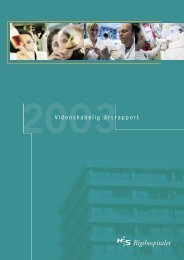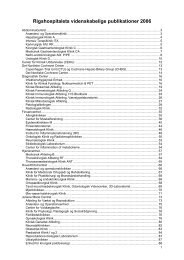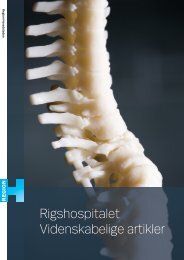View - CTU
View - CTU
View - CTU
You also want an ePaper? Increase the reach of your titles
YUMPU automatically turns print PDFs into web optimized ePapers that Google loves.
Fig. 4. The point A represents half the distance of the spread of<br />
the radiolucent carious dentin along the enamel-dentin junction<br />
(dotted line). Point B was placed at the pulpal border of the<br />
rndiolucenl area, and Cal the border of the pulp. The ratio AB/<br />
AC defines the maximum penetration depth of the caries lesion.<br />
temporary restoration could be properly placed no further<br />
excavation was carried out. leaving soft, wet, and discoloured<br />
dentin centrally on the p~ilpal wa1!. A calcium<br />
hydroxide base material (Dycal; DeTrey Dentsply. Skarpniick.<br />
Sweden) was applied over the remaining carious<br />
dentin and the cavity was temporarily sealed with glassionorner<br />
(Ketac Molar; 3M ESPE, Glostrup, Denmark).<br />
After 8 to 12 wk, the cavity was re-entered and the final<br />
excavation was carried out leaving only central yellowish or<br />
greyish hard dentin (equal to the hardness of sound dentin,<br />
as judged by gentle probing). A calcium hydroxide base was<br />
applied and the cavities were restored with OptiBond Solo<br />
Plus (KerrHawe) and Herculite XRV (KerrHawe).<br />
Direct complete excavation was completed during the first<br />
visit. Criteria for evaluating the remaining dentin were<br />
identical to those used at the second visit in the stepwise<br />
excavation group. Base material and a temporary restoration<br />
were placed as described above. At the second visit<br />
(8-12 wk later) the temporary restoration, but not the base<br />
material, was removed and replaced with a permanent<br />
restoration, as described above.<br />
Direct pulp capping was performed after complete<br />
removal of carious dentin using hand excavation instruments<br />
(LM 533-534, LM 63-6< LM 631-641; LM-instruments,<br />
Parainen. Finland) in the final excavation, followed<br />
by isolation of the tooth with a rubber dam and cleaning<br />
with alcohol containing 5 mu 1111- 1 of chlorhexidine. The<br />
exposed pulp was irrig~1ted \~'ith sterile saline. Following<br />
haemostasis (within 5 min) calcium hydroxide cement was<br />
applied (Dycal; DeTrey Dentsply, Sweden). The cement was<br />
covered with a temporary restoration (Ketac Molar; 3M<br />
ESPE). After I month the cavity was restored with<br />
OptiBond Solo Plus (KerrHawe) and Herculite XRV<br />
(KerrHawe). At the final restoration procedure a thin layer<br />
of the temporary restoration was left covering the pulp<br />
capping area to ensure that exposure to the oral environment<br />
was avoided.<br />
The procedures and materials used for the partial pulpotomy<br />
were identical to those in the direct pulp capping<br />
group except that 1-1.5 mm of the pulp tissue (13) was<br />
removed using a high-speed round diamond bur under<br />
water spray coolant.<br />
The treatment results were assessed after 1 yr. In the<br />
stepwise excavation trial the prinutry outcome measure was<br />
unexposed pulps with sustained pulp \'itality without apical<br />
Trear men/ of' deep caries in m/11//s 293<br />
radiolucency (=success). Pulp vitality was defined as a<br />
positive response to thermal (cold) or electrical stimulation.<br />
Periapical radiolucem:y was diagnosed if the apical part of<br />
the periodontal ligament space was at least twice as wide as<br />
in other parts of the root and the lamina dura was absent.<br />
Two blinded observers independently examined the radiographs.<br />
Inter-examiner agreement in the determination of<br />
success or failure was judged as good (Kappa = 0.67). ln 15<br />
cases. the observers disagreed and they had to reach consensus.<br />
The consensus result was 12 successes and 3 failures.<br />
Patients who had to be treated with pulpectomy (because of<br />
unbearable pain) before the I-yr follow-up were classified as<br />
failures.<br />
Patients with mild-to-moderate pretreatment pain were<br />
included in the excavation trial, and the secondary outcome<br />
measure was the extent of pain relief on days I and 7<br />
following excavation. The level of pretreatment pain was<br />
assessed just before treatment (Table I) on the first visit<br />
using a 100 mm visual analogue scale (VAS) printed on<br />
paper ranging from 'no pain' to 'unbearable pain'. The<br />
patients were asked to make similar assessments at home<br />
on days 1 and 7 after excavation and to return the<br />
assessments by mail. Pain relief (secondary outcome measure)<br />
was defined as the difference in VAS scores (mm)<br />
between the pretreatment pain and pain on day 1 [median<br />
(mean)] and day 7 [median (mean)] after excavation.<br />
The tertiary outcome measure was pulp exposure during<br />
excavation.<br />
In the pulp capping trial (Fig. 1 ), the primary outcome<br />
measure was pulp vitality without apical radiolucency.<br />
Statistical analysis<br />
The statistical investigator was unaware of the allocation<br />
codes. The non-Gaussian distributions of the VAS scorings<br />
were compared between the intervention groups using a<br />
non-parametric test (Mann-Whitney U-test). The mean<br />
ratio of the caries lesion depth was presented with 95"/.,<br />
confidence interval (Cl). The binary outcomes were<br />
analyzed by comparing the probability of success (Chisquare<br />
test) and by reporting the difference between intervention<br />
groups along with the 95% CI. In addition, binary<br />
logistic regression analysis ( 16) was performed to assess the<br />
effect of treatment, while adjusting for age, pretreatment<br />
pain, and treatment centre. Odds ratio (OR) estimates were<br />
presented with 95% Cl. The level of significance (two-sided)<br />
was set to 0.05.<br />
Results<br />
We evaluated 440 patients for eligibility to participate in<br />
this study bet ween February 2005 and April 2007. Of<br />
these patients, 126 were excluded because they did not<br />
meet the inclusion criteria, refused to participate, or<br />
underwent treatment al other clinics. Thus, 314 patients<br />
were randomized to stepwise excavation vs. direct complete<br />
excavation (Fig. I). The baseline values of the<br />
demographic variables and VAS scorings of pretreatment<br />
pain are shown in Table 1, including the mean<br />
depth ratio of the caries lesions. The median number of<br />
days of the observation period was 476 (interquartile<br />
range 442-559) in the stepwise excavation group and 477<br />
(interquartile range 434-524) in the direct complete<br />
excavation group.<br />
294 Bjerndal et al.<br />
Variables<br />
Demographic ·<br />
Menn(%) ,<br />
Median age (yr) (IQR)<br />
Age < 50 yr 11 (%)<br />
Type of tooth<br />
Incisor/canine 11 (%)<br />
Premolar 11 (%)<br />
Molarn (%)<br />
Lesion site<br />
Approximal 11 (%)<br />
Mean depth ratio of cari<br />
Median pretreatment pai<br />
Centre<br />
Centre 1 n (%)<br />
Centre 2 n (%)<br />
Centre 3 n (%)<br />
Centre 4 n (%)<br />
Centre 5 11 (%)<br />
Centre 6 11 (%)<br />
CI, conndence interval;<br />
Randomized<br />
( 11 = analyzed teeth)<br />
Success<br />
Pnlp vitality without<br />
Failures<br />
Pulp exposure n (%)<br />
Pulp vitality with api•<br />
No pulp vitality with<br />
Unbearable pain' 11 (<br />
'Resulting in pulpecto<br />
CI, confidence interva<br />
The results from<br />
in Table 2. The stt<br />
nificantly higher pr<br />
low-up compared 1<br />
group (62.4%) (P<br />
significant when ad.<br />
centre (Table 3). 1<br />
(17.5%) after the st<br />
of these teeth the p<br />
exposed at the firs<br />
vation group the p<br />
The estimated dim<br />
1.2-21.3 (P = 0.0<br />
also statistically<br />
adjusted for the eff<br />
Considering only<br />
pulps, 89.8% of<br />
without apical rad<br />
tion vs. 87.7% afl<br />
not significant).








